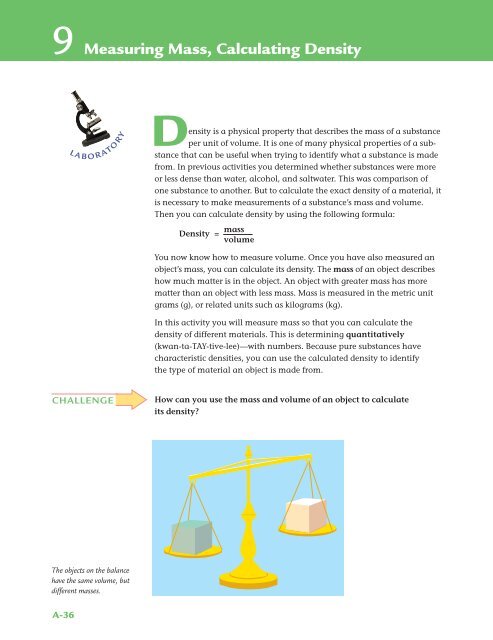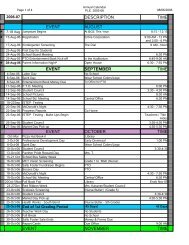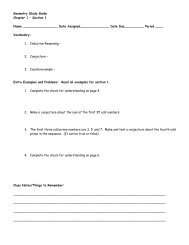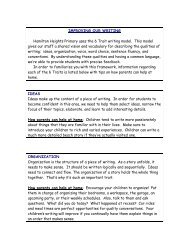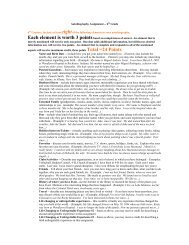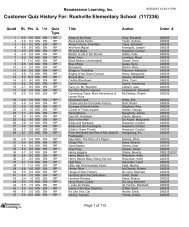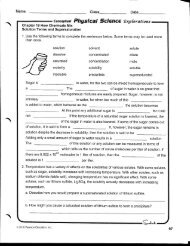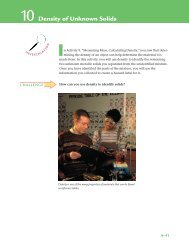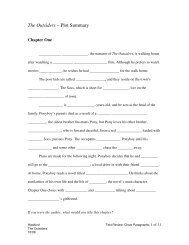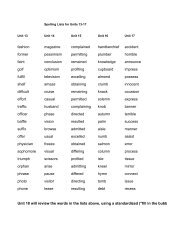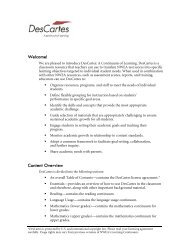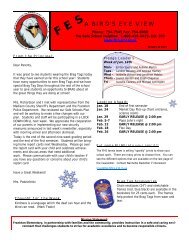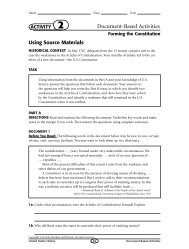9 Measuring Mass, Calculating Density - EZWebSite
9 Measuring Mass, Calculating Density - EZWebSite
9 Measuring Mass, Calculating Density - EZWebSite
Create successful ePaper yourself
Turn your PDF publications into a flip-book with our unique Google optimized e-Paper software.
9 <strong>Measuring</strong> <strong>Mass</strong>, <strong>Calculating</strong> <strong>Density</strong><br />
L A B O R ATO R Y<br />
<strong>Density</strong> is a physical property that describes the mass of a substance<br />
per unit of volume. It is one of many physical properties of a substance<br />
that can be useful when trying to identify what a substance is made<br />
from. In previous activities you determined whether substances were more<br />
or less dense than water, alcohol, and saltwater. This was comparison of<br />
one substance to another. But to calculate the exact density of a material, it<br />
is necessary to make measurements of a substance’s mass and volume.<br />
Then you can calculate density by using the following formula:<br />
<strong>Density</strong> = mass<br />
volume<br />
You now know how to measure volume. Once you have also measured an<br />
object’s mass, you can calculate its density. The mass of an object describes<br />
how much matter is in the object. An object with greater mass has more<br />
matter than an object with less mass. <strong>Mass</strong> is measured in the metric unit<br />
grams (g), or related units such as kilograms (kg).<br />
In this activity you will measure mass so that you can calculate the<br />
density of different materials. This is determining quantitatively<br />
(kwan-ta-TAY-tive-lee)—with numbers. Because pure substances have<br />
characteristic densities, you can use the calculated density to identify<br />
the type of material an object is made from.<br />
CHALLENGE<br />
How can you use the mass and volume of an object to calculate<br />
its density?<br />
The objects on the balance<br />
have the same volume, but<br />
different masses.<br />
A-36
<strong>Measuring</strong> <strong>Mass</strong>, <strong>Calculating</strong> <strong>Density</strong> • Activity 9<br />
MATERIALS<br />
For each group of four students<br />
1 set of six objects:<br />
light gray cube<br />
dark gray cube<br />
light gray cylinder<br />
dark gray cylinder<br />
light gray bar<br />
dark gray bar<br />
For each pair of students<br />
1 balance<br />
1 pair of plastic forceps<br />
1 calculator<br />
For each student<br />
Student Sheets 8.1a and 1b, “Two Methods to<br />
Measure Volume”<br />
SAFET Y<br />
Review the procedure, and decide on appropriate safety measures for<br />
working with the unknown solids. If you do not know what material an<br />
object is made from, assume it is hazardous until you prove otherwise.<br />
PROCEDURE<br />
Part A: <strong>Measuring</strong> <strong>Mass</strong><br />
1. Obtain the same set of objects you used in Activity 8, “<strong>Measuring</strong><br />
Volume.”<br />
2. In your science notebook, create a data table similar to Table 1, ”<strong>Mass</strong>,<br />
Volume, and <strong>Density</strong> of Six Objects,” on the next page. You will use it to<br />
record your data and calculations.<br />
3. Divide the six objects into two sets so that each pair in your group has<br />
either the light gray set or the dark gray set. Each pair will begin by<br />
determining the masses of the three objects in one set.<br />
4. Use a balance to find the mass of each object to the nearest 0.1 gram (g).<br />
Record your data in your table.<br />
5. Exchange objects with the other half of your group, and repeat Step 4.<br />
A-37
Activity 9 • <strong>Measuring</strong> <strong>Mass</strong>, <strong>Calculating</strong> <strong>Density</strong><br />
Part B: <strong>Calculating</strong> <strong>Density</strong><br />
6. In Table 1, record the volume of each object from Student Sheet 8.1b,<br />
“Two Methods to Measure Volume.”<br />
7. Work with your partner to calculate the density of each object, dividing<br />
its mass by its volume. Record this data in your table.<br />
<strong>Density</strong> = mass<br />
volume<br />
8. Compare your results with the results of the other pair of students in<br />
your group. If you think any of your results are inaccurate, repeat your<br />
measurements and your calculations.<br />
Table 1: <strong>Mass</strong>, Volume, and <strong>Density</strong> of Six Objects<br />
Object <strong>Mass</strong> (g) Volume <strong>Density</strong> <strong>Density</strong><br />
(cm 3 or mL) calculation (g/cm 3 or g/mL)<br />
Light gray<br />
bar<br />
Dark gray<br />
bar<br />
Light gray<br />
cube<br />
Dark gray<br />
cube<br />
Light gray<br />
cylinder<br />
Dark gray<br />
cylinder<br />
A-38
<strong>Measuring</strong> <strong>Mass</strong>, <strong>Calculating</strong> <strong>Density</strong> • Activity 9<br />
Part C: Using <strong>Density</strong> to Identify Materials<br />
9. Now that you have calculated the density of several objects, you will use<br />
this to identify the material each of the objects is made from. In your<br />
science notebook, make a table similar to Table 2, “Identifying Objects’<br />
Material Using <strong>Density</strong>.”<br />
Table 2: Identifying Objects’ Material Using <strong>Density</strong><br />
Name of object <strong>Density</strong> calculated Closest density from Table 3 Object’s material<br />
10. In your new table, fill in the name and density calculated for each<br />
object from Table 1, “<strong>Mass</strong>, Volume, and <strong>Density</strong> of Six Objects.”<br />
11. Compare the densities you calculated in Table 2 with the densities shown<br />
in Table 3, “Densities of Selected Solids,” on the next page. Find the<br />
density closest to the density of each object, and enter that in Table 2.<br />
12. Identify the material that might make up each of the six objects.<br />
Hint: Look for the material that has a density closest to the density that<br />
you determined for each object. Write the density and the material of<br />
this object in Table 2.<br />
This bowling ball and balloon<br />
have very similar volumes,<br />
but because the bowling ball<br />
has more mass per volume,<br />
it is more dense.<br />
A-39
Activity 9 • <strong>Measuring</strong> <strong>Mass</strong>, <strong>Calculating</strong> <strong>Density</strong><br />
ANALYSIS<br />
1. What material is each metallic solid made of? Use data from this<br />
activity to support your explanation.<br />
2. Now that you have identified what each solid is made of, look at the<br />
hazards for each in Table 2, “Information on Selected Solids,” in Activity 7.<br />
What safety precautions must you take when working with these<br />
materials?<br />
3. A block of wood is 4 cm wide, 5 cm long, and 10 cm high. It weighs<br />
100 grams.<br />
a. Calculate its volume.<br />
b. Calculate its density.<br />
c. Will the block sink or float in water? Explain. (Remember, the<br />
density of water is 1.0 g/cm 3 .)<br />
d. Imagine cutting the block into two exactly equal halves.<br />
Calculate the volume, mass, and density of each piece.<br />
e. How do the densities of the new pieces compare with the density<br />
of the original block? Use your answer to Question 3d and a<br />
diagram to illustrate your answer.<br />
Table 3: Densities of Selected Solids<br />
Type of solid material <strong>Density</strong> (g/cm 3 )<br />
Plastics<br />
High-density polyethylene (HDPE) 0.95<br />
Polystyrene (PS) 1.1<br />
Polyvinyl chloride (PVC) 1.3<br />
Metals<br />
Magnesium 1.7<br />
Beryllium 1.9<br />
Aluminum 2.7<br />
Titanium 4.5<br />
Zinc 7.1<br />
Iron 7.9<br />
Tungsten 19.4<br />
A-40


